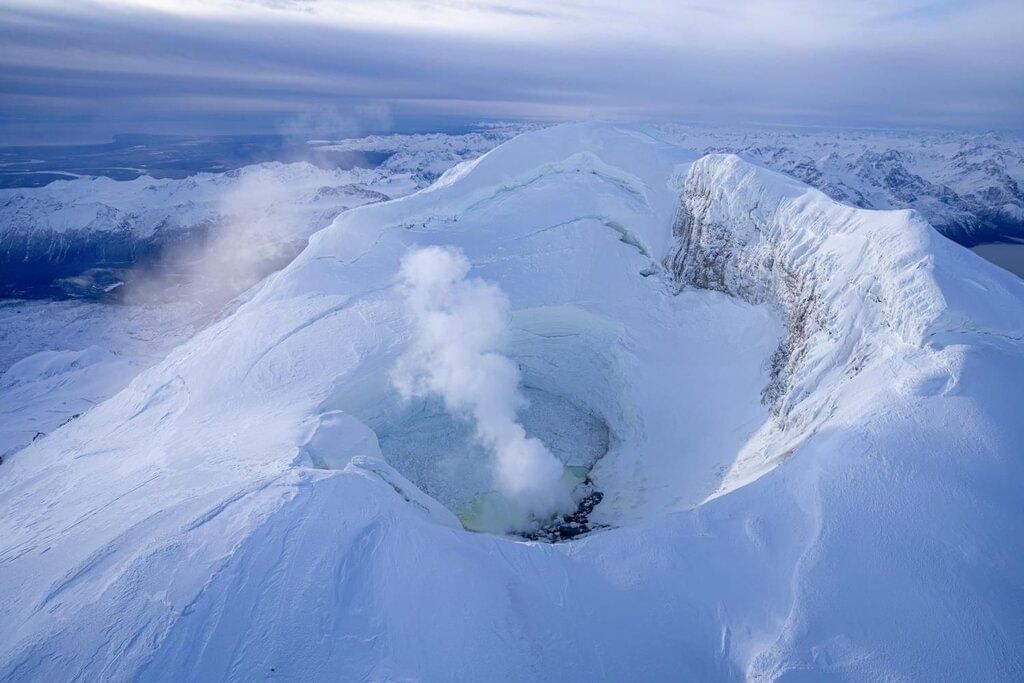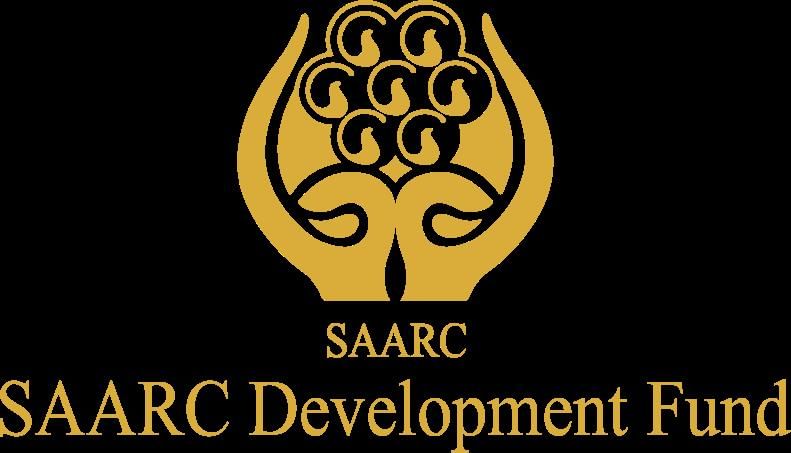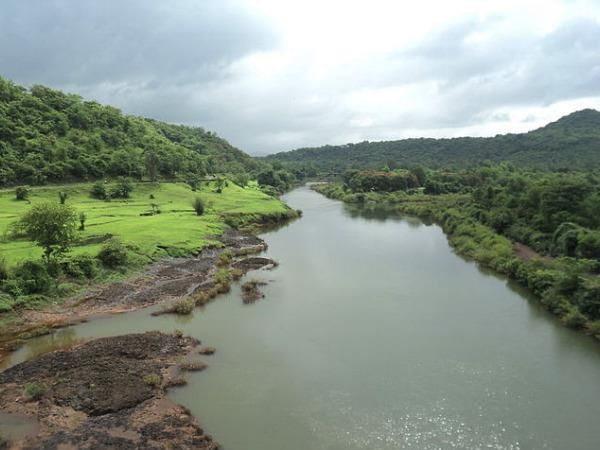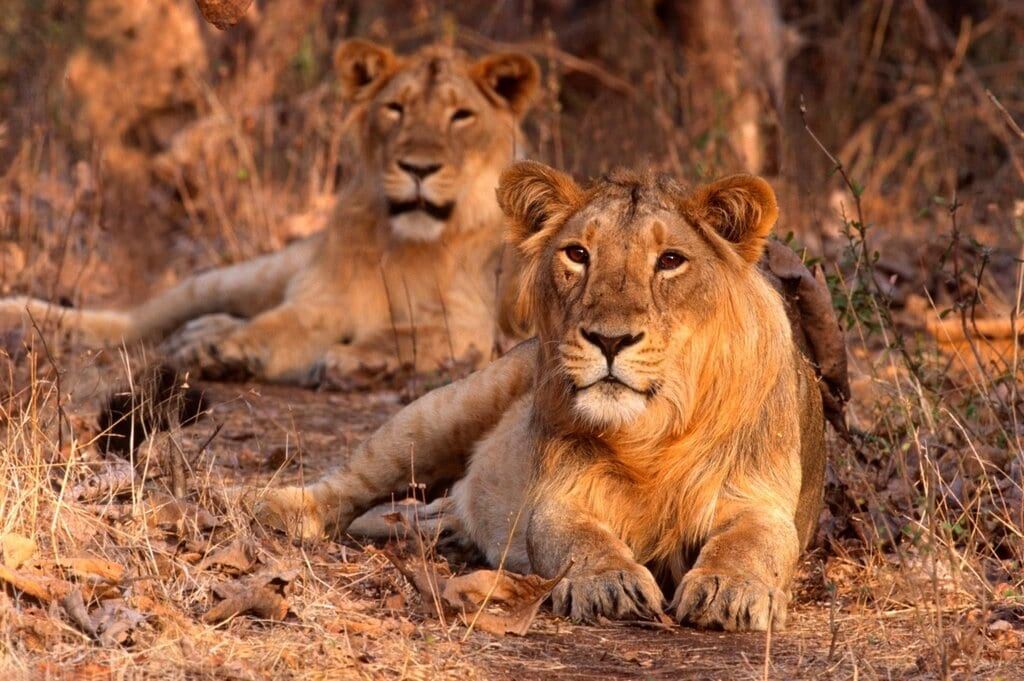UPSC Daily Current Affairs- 12th April 2025 | Current Affairs & Hindu Analysis: Daily, Weekly & Monthly PDF Download
GS1/ Geography
Mount Spurr

Why in News?
Recently, a series of small earthquakes have been shaking Alaska's Mount Spurr, raising concerns among scientists about the possibility of a significant volcanic eruption.
Overview of Mount Spurr
- Mount Spurr is an active stratovolcano complex located in the north-central Cook Inlet region of Alaska, approximately 100 kilometers west of Anchorage.
- The volcano stands at about 3,000 meters (11,000 feet) high and is covered in ice and snow.
- It is primarily made up of andesite, a type of volcanic rock.
- Mount Spurr features a breached stratovolcano, a lava dome at its summit, and Crater Peak vent, a small stratocone on its southern flank.
- The summit is topped with a caldera measuring 5 by 6 kilometers.
- Around 10,000 years ago, the mountain experienced a crater collapse that formed Chakachamna Lake.
- There is currently an active icefield within the caldera, along with multiple glaciers.
- The last eruption of Mount Spurr occurred in 1992, causing significant ashfall and disrupting air travel in the region.
GS3/ Environment and Ecology
The conservation argument for resurrecting dire wolf is not credible

Why in News?
Colossal Biosciences is an American company that uniquely combines genetics and conservation to bring back species that have been extinct for thousands of years.
Goals of De-extinction Project
Colossal Biosciences focuses on reviving extinct species using advanced genetic engineering techniques.
Projects by Colossal Biosciences
Woolly Mammoth De-Extinction
- Colossal is working on reviving the woolly mammoth by using CRISPR technology to integrate mammoth genes into the Asian elephant genome.
- The aim is to create a cold-resistant elephant with traits similar to the woolly mammoth, such as a thick layer of fat and shaggy hair.
- These modified elephants are intended to inhabit Arctic tundra regions and potentially help combat climate change.
Dire Wolf Revival
- Colossal announced the successful birth of three genetically engineered dire wolf pups named Romulus, Remus, and Khaleesi.
- Using DNA from ancient dire wolf remains, scientists edited the genes of modern gray wolves to create animals with traits resembling the extinct dire wolf, such as larger size and distinctive fur color.
Criticisms of De-extinction for Conservation
Critics raise concerns about the credibility of reviving extinct species for conservation due to several factors:
Lack of Scientific Proof
- The success of reviving species like the woolly mammoth has not been proven through rigorous scientific peer review or established results.
Limited Genetic Editing
- The genetic editing involved in reviving species often targets only a small number of genes, resulting in incomplete or flawed replicas of the original species.
- For example, in the case of the dire wolf, only 20 genes were edited, leading critics to describe the outcome as a “strange-looking gray wolf” rather than a true de-extinct species.
Ethical Concerns
- There are ethical debates regarding the potential consequences of creating species that may not be able to thrive in the modern environment or could cause unforeseen ecological imbalances.
- For instance, introducing revived species like the woolly mammoth could disrupt existing ecosystems in ways that may not be beneficial.
How Woolly Mammoths Can Help Combat Global Warming
Restoring Grasslands
- Woolly mammoths can play a crucial role in restoring Arctic grasslands by grazing on shrubs and plants.
- This grazing activity prevents the growth of shrubs, which trap heat and promote the return of cooler grasslands.
- The restoration of these grasslands is essential for maintaining permafrost, as they reflect more sunlight and absorb less heat.
Slowing Permafrost Melt
- Grasslands, which are promoted by mammoth grazing, absorb less heat than shrub forests.
- This helps keep the permafrost cool and slows its melting, which is crucial because melting permafrost releases methane, a potent greenhouse gas.
- By keeping the ground cooler, woolly mammoths can help reduce the rate of methane release into the atmosphere.
Preventing Methane Emissions
- As permafrost thaws, it releases large amounts of methane into the atmosphere, contributing to global warming.
- Woolly mammoths can mitigate this by maintaining ecosystems that slow down permafrost thawing.
- Their grazing helps keep the tundra cooler, making it less prone to releasing methane.
Enhancing Carbon Sequestration
- Grasslands are more effective at absorbing carbon dioxide (CO2) than shrub or forested areas.
- By converting tundra back into grasslands, woolly mammoths can enhance carbon sequestration, storing more carbon in the soil.
- Healthy grasslands act as carbon sinks, absorbing more CO2 from the atmosphere and helping combat climate change.
India’s Position in Advanced Genetic Engineering
Advancements in Agricultural Biotechnology
- India has established a regulatory framework for genetically modified organisms (GMOs) under the Environment (Protection) Act of 1986.
- Recently, India has begun trials of CRISPR/Cas9-modified rice varieties, indicating a rise in scientific research and innovation in plant genome editing.
Pioneering Genomic Research and Precision Medicine
- The Genome India Project aims to sequence at least 10,000 Indian genomes to develop predictive diagnostic indicators for various diseases.
- Institutions like the Institute of Genomics and Integrative Biology (IGIB) have contributed to understanding genetic epidemiology, including the development of the FELUDA COVID-19 test based on CRISPR technology.
Way Forward
Strengthening Ethical and Regulatory Frameworks
- India should develop robust regulations and ethical guidelines for genetic engineering, particularly for gene-editing technologies like CRISPR.
- Ensuring safety and sustainability in agriculture and medicine is crucial for public trust and environmental protection.
Promoting Collaborative Research and Innovation
- Encouraging partnerships between academic institutions, the private sector, and the government will accelerate research and application of advanced genetic technologies.
- This collaborative approach can position India as a global leader in biotechnology innovation and ensure that the benefits of genetic engineering are realized across various sectors.
GS2/ International Relations
SAARC Development Fund (SDF)

Why in News?
The SAARC Development Fund (SDF) is gaining attention due to recent cuts in USAID funding.
- The SDF, with a capital base of $672 million and $1.5 billion in authorized funds, focuses on social, economic, and infrastructure development across SAARC countries.
Establishment and Evolution
- The SDF was established in 2010 by SAARC member countries: Afghanistan, Bangladesh, Bhutan, India, Maldives, Nepal, Pakistan, and Sri Lanka.
- It evolved from the SAARC Fund for Regional Projects and the SAARC Regional Fund proposed in 1990.
- In 2005, the SDF was reconstituted as the umbrella financial mechanism for all SAARC projects and was endorsed in 2006.
- The Charter was signed in 2008 during the 15th SAARC Summit in Colombo, and the permanent Secretariat opened in 2010 in Thimphu, Bhutan.
Funding Mechanism
- The SDF operates on a collaborative funding model, with contributions from member countries and development partners.
- Member countries contribute to the SDF’s capital, and funds are allocated for regional projects based on proposals from member states.
- The SDF aims to expand its credit portfolio to $300 million in the coming years.
GS2/ Governance
PM-POSHAN Scheme
Why in News?
The PM-POSHAN (Pradhan Mantri Poshan Shakti Nirman) Scheme has seen a 9.5% increase in material costs, leading to an additional expenditure of ₹954 crore by the Centre for the 2025-26 financial year.
About PM-POSHAN Scheme
- The PM-POSHAN Scheme, previously known as the Mid-Day Meal Scheme, is a government initiative aimed at providing hot, cooked meals to children in government and government-aided schools across India.
- Launched by the Ministry of Education, the scheme aims to improve children’s nutritional status, increase school participation, and enhance retention and attendance rates.
- It works in conjunction with initiatives like POSHAN Abhiyan and Mission POSHAN 2.0 to improve overall nutrition among children and mothers.
Key Features
- Target Group: The scheme serves 11.20 crore children in pre-primary classes (Balvatikas) and Classes 1-8 across 10.36 lakh schools, with a special focus on disadvantaged children from low-income backgrounds.
- Nutritional Goals: The scheme aims to provide balanced meals that meet the nutritional needs of children, including specific quantities of pulses, vegetables, and oil for both primary and upper primary students.
- Model: The Centre funds 100% of food grains through the Food Corporation of India (FCI), while States are responsible for meal implementation.
Funding Pattern
- 60:40 between Centre and States/UTs with legislature.
- 90:10 for Northeastern and Himalayan States.
- 100% central funding for Union Territories without legislature.
Additional Components:
- The scheme includes a component for promoting the development of School Nutrition Gardens in schools.
- Social Audit:. social audit of the scheme is mandatory in all districts to ensure transparency and accountability.
GS1/ Geography
Mahadayi River

Why is it News?
Recently, a diverse group including farmer leaders, environmentalists, religious figures, and advocates united to protest against the state government's plan to acquire land for the Bandura Nala water diversion project in the Mahadayi river basin.
About the Mahadayi River
- The Mahadayi River, also known as the Mandovi or Mhadei River, is a crucial rain-fed water source shared by Karnataka and Goa.
- Origin: The river originates from the Bhimgad Wildlife Sanctuary in the Western Ghats, Karnataka.
- Course: It flows briefly through Maharashtra before entering Goa, where it stretches for about 76 km of its total 111 km length, before emptying into the Arabian Sea at Panaji, Goa.
- Tributaries: The river has several tributaries, including Rogaro, Kushavati, Nanorem, Nanuz, Valvota, and Mapusa.
- Significance: Panaji, the capital of Goa, and the historic town of Old Goa are located on the left bank of the Mandovi River. The Salim Ali Bird Sanctuary is situated on Chorao Island in the river.
What is the Kalasa-Banduri Project?
- The Kalasa-Banduri project aims to construct dams and a canal system to redirect water from the Mahadayi River in Goa to the Malaprabha River basin in Karnataka.
- Objective: The primary goal is to supply drinking water to the districts of Belagavi, Dharwad, Bagalkot, and Gadag in Karnataka.
- History: Proposed by the Karnataka Government in the 1980s, the project has faced opposition from Goa.
GS3/ Environment and Ecology
Asiatic Lions

Why in News?
Asiatic lions are gradually extending their habitat beyond the Gir forests, frequently crossing state boundaries and exploring coastal regions such as Diu Island.
About Asiatic Lions
- The Asiatic lion, scientifically known as Panthera leo persica, is also referred to as the Persian Lion or Indian Lion.
- This subspecies is found exclusively in India, primarily within the Gir National Park and Wildlife Sanctuary located in Gujarat.
- Historically, Asiatic lions roamed widely across West Asia and the Middle East. However, they have become extinct in these areas, with India now serving as the last stronghold for this species.
- Current Distribution: According to the most recent lion census conducted in 2020 by the Gujarat Forest Department, there are 674 lions distributed over 30,000 square kilometers across nine districts and 53 talukas in Saurashtra.
- Due to ongoing conservation efforts, the International Union for Conservation of Nature (IUCN) upgraded the status of the Asiatic lion from “Critically Endangered” in the 1990s to “Endangered” since 2008 on its Red List.
About Gir and Girnar
- Gir National Park and Wildlife Sanctuary was established in 1965, covering an area of 1,412 square kilometers, with an additional buffer zone of 470 square kilometers. This brings the total protected habitat to 1,882 square kilometers.
- Girnar Wildlife Sanctuary, founded in 2008, is situated in the Junagadh district and encompasses the Girnar hills in the Saurashtra region. This sanctuary features dry deciduous forests with tree species such as teak, dhak, and acacia. It is home to a variety of wildlife, including Asiatic lions, leopards, Chinkara, Chousingha, and over 300 bird species.
- The Girnar Sanctuary serves as an extension habitat for lions, providing additional space for these animals beyond the Gir National Park.
GS1/ Geography
El Niño Southern Oscillation (ENSO)
Why in News?
The National Oceanic and Atmospheric Administration (NOAA) has confirmed the end of the recent La Niña event in the tropical Pacific Ocean, marking a transition to ENSO-neutral conditions.
Understanding ENSO and its Phases
- The El Niño Southern Oscillation (ENSO) is a crucial climate phenomenon involving changes in sea-surface temperatures (SST) in the central and eastern tropical Pacific Ocean.
- ENSO significantly impacts global weather patterns, including wind behavior, atmospheric pressure, and rainfall distribution.
- El Niño. Characterized by warmer-than-usual sea surface temperatures, often associated with unusual global warming patterns.
- La Niña. Involves cooler-than-usual sea surface temperatures, typically linked with colder atmospheric patterns and stronger trade winds.
- ENSO-Neutral. A phase where neither El Niño nor La Niña dominates the climate system, leading to less certain forecasts and often acting as a transitional period between the two extremes.
ENSO-Neutral Phase
- The ENSO-neutral phase is generally viewed as a transitional period between El Niño and La Niña.
- In March 2025, NOAA scientists noted that SST anomalies in the Niño-3.4 region had reached -0.01°C, significantly warmer than the La Niña threshold of -0.5°C.
- The cool waters that were characteristic of La Niña in previous months have now dissipated.
- Despite the presence of some La Niña-like atmospheric conditions, such as strong trade winds, the absence of cool SSTs has led to the declaration of ENSO-neutral conditions.
- Temperature and Atmospheric Changes. The transition to neutral conditions occurred as warm waters spread westward across the eastern Pacific, while the pool of cool water beneath the surface began to diminish.
- Although signs of La Niña, like strong trade winds, persisted for a brief period, the lack of cold surface waters meant the system no longer met the criteria to be classified as La Niña.
|
55 videos|5389 docs|1141 tests
|
FAQs on UPSC Daily Current Affairs- 12th April 2025 - Current Affairs & Hindu Analysis: Daily, Weekly & Monthly
| 1. What is Mount Spurr and why is it significant? |  |
| 2. What are the main arguments against resurrecting the dire wolf? |  |
| 3. What is the SAARC Development Fund (SDF) and its purpose? |  |
| 4. What is the PM-POSHAN Scheme and its objectives? |  |
| 5. How does the El Niño Southern Oscillation (ENSO) affect global weather patterns? |  |





















